Women and Painting: The Changing Overview of Modern Indian Art
Abstract:
Gender is a very complex issue and related to every sphere of human life. This very complexity has been channelized through certain issues of male-dominancy over the woman. In art, such inequalities and gender politics have also been represented through visual representation. In modern Indian paintings, there are numerous renowned artists, who have painted the woman as a major theme. The woman is frequently adopted as a subject from the ancient age. This adoption is exclusively related to socio-political factors and gender disparities. Such political narratives have been subverted after the involvement of female artists through the projection of feministic issues and ancillary forms. The objectification of women can be particularly observed through the paintings of Raja Ravi Varma, which is still followed by numerous male artists. Unlike, such political representation has also been entirely opposed by the Indian feminist artist, Amrita Sher-Gill and it is still prevailed by many female artists. Therefore, the gender difference, in respect of woman's portrayal has been derived through the ideology of the individuals (both male and female). Thus, the paper will be an attempt to explore the representation of women in modern Indian paintings, particularly from the colonial period. The observation will be based on a comparative analysis between the major male and female artists to assess the role of gendering the portrayal of womanhood. The representation of female artists is entirely different than the male artist in theme, representation, gestures, and so on.
Keywords- Gender, Subjectivity, Objectification, Erotic-art, Portrayal of Women and Modern Indian Paintings
Introduction
After the mark of the 19th century, the seeds of modern traditions have been observed by numerous art critics; but there is no certain point, which can be considered particularly as 'modern'. Likewise, there are various styles of painting, which are considered modern but modernity in Indian paintings have been calculated during Colonialism. After the arrival of East India Company, Indian art has been channelized through various academic institutions as art colleges. These art colleges have contributed a lot to give Indian art a new paradigm for its development. On the contrary, their European academic module of art training has not been accepted entirely by all, but their role cannot be neglected in the improvisation of Indian paintings. Moreover, some of the critics who were writing about Indian art have criticized the colonial period for degrading artistic representations of India. In this context, the words of Garimellla (1998) cannot be avoided, who stated that historical writings and academic institutional practices of the colonial period were the main cause to degrade its quality and to politicize its roots after calling the art feminine. She further added that the Indian Nationalist movement is also responsible for this degradation because their art was a response for such political construction and paintings have been equipped by them to construct an authentic nationalism [1]. In this way, art has become a medium for political agencies, in which the significance of ancient art has lost its identity and the new production has lost its novelty. In a close observation of artistic representation, it has been found that from the very ancient time, the projection of women showcases the physical or ideal roles of a woman but after the mark of modern the scenario was changed entirely.In the domain of modern paintings, the name of Raja Ravi Varma cannot be forgotten; whose female imagery ruled the Indian art world till the contemporary times. He is also considered as the father of modern Indian paintings as he is the first one, who used oil colors in his paintings and handled his work with Western techniques. Raja Ravi Varma had been formalizing the tools and techniques of Western paintings after molding them in the Indian mythological theme [2] [3] [4]. In context to female artists, the major approach has been considered through the paintings of Sher-Gill. The cold war between the subjective and the objective can be overlooked through these paintings. The first female artist of the twentieth century in India is considered Sunayni Devi, who depicted the folk primitive series in her paintings and contributed to the realm of women empowerment and professionalism through paintings [5].
Thus, after the feministic approach of Sher-Gill, numerous female artists have adopted feministic ideologies in their paintings and Indian modern paintings have been differentiated into two approaches. The first approach belonged to the Objectification of the woman by male artists, and the second one belonged to a subject-oriented theme by a female artist. These approaches are not entirely dependent upon the ideologies of both the artists, but it also belonged to the ideology of its onlookers. As production of art, every individual has the right to paint as per likeness but the production may become questionable when it belongs to someone (woman and her body, which is only belonged to womanhood). In Indian paintings, the main precursors of modernism, who frequently depicted women as a subject in sensuous/political/ideal form are Ravi Varma, Avanidrantah Tagore, Nand Lal Bose, F. N. Souza, M. F. Hussein, Jatin Das, A. Ramchandran, and so on. In the list of feminist artists, after the name of Amrita Sher-Gill, numerous women contributed the same quest through paintings, for instance, Anjolie Ela Menon, Arpita Singh, GogiSaroj Pal, Bharti Kher, Nalini Malini, RekhaRodwittiya, Seema Kohli and many more.
Research Methodology
The study is based on a comparative analysis of male and female artists which gives an overview of the projection of women from ancient to modern paintings. Some major theories of feminism and gender studies have been applied to evaluate the projection of women in modern Indian paintings. The qualitative research methods have been followed for the assessment of the gestures, posture, colour application, and theme of the artworks. The factors which are responsible for such gender binaries have also been reconsidered for assessing the role of woman as a subject, and an artist as well. The subjects which are common and repeated as per the Indian context, have been selected to build the frame of this comparative analysis. The works of Amrita Sher-gill and Ravi Varma have been taken as a stereotype to judge the ongoing influence of the term gender. The ongoing social and political movement has also been revisited for the particular period (when the artworks were created) to explore the impact of these aspects on the work of artists.
Gender and Art
Gender and art have been associated with each other from the very dawn of artistic representation but may not come into light earlier because a woman is remained neglected in the art field as like other occupations. During the 19th century, the participation of women has been started in all working sectors including paintings. In the Indian scenario, gender politics has been noticed by a group of female critics, where VidyaDehejia was probably the first art critic, who noticed gender significance in art and edited a book titled, Representing the Body: Gender Issues in Indian Art [6] ', in which a group of critics contributed their thoughts on gender politics in art. The term gender has caught its roots during the 1960s, where a group of social activists has started fights for the equality of woman in the society in every sphere, but in paintings, the word gender has come into existence after the world-famous essay of Linda Nochlin, " Why Have There Been No Great Women Artist [7]", in which she criticized the social as well as institutional practices and looked up for the history of having female artists. In the Indian context, Dahejia was probably the first one, who raised gender issues and feministic interventions in the history of Indian art. Going through the history of female artists, the minority of females is a vexed phenomenon, which may be a cause for the objectification of women in paintings. In modern Indian paintings, female artists have entered into the field of art, where first female artists are considered Amrita Sher-Gill (1913-1941), Indo-Hungarian artists, who took her academic training in Paris and then came to India.
Thus, after the feministic approach of Sher-Gil, numerous female artists have adopted feministic ideologies in their paintings, and Indian modern paintings have been differentiated into two approaches. The first approach belonged to the objectification of women by male artists, and the second one belonged to the subject-oriented theme by the female artists. These approaches are not entirely dependent upon the ideologies of both the artists, but they also belonged to the ideology of their onlookers. As production of art, every individual has the right to paint what he likes, but the production may become questionable when it belongs to gender politics. In India, there areseveral art activities, which have been formed in various groups and contributed significantly to the promotion of paintings. In these groups, PAG has been founded by Francis Newton Souza in 1947 and M.F. Husain, SaiyadHaider Raza, K. H. Aara, V. S. Gaitondey are the main artists of this group. All members of this group have a universal significance in the field of art and proved the landmarks of Indian modern paintings. M. F. Husain considered the leading pioneer for the modernization of the pan-Indian realm. Husain, who remained in controversies, has depicted uncountable paintings themed with female nude in which he has drawn the Indian religious icons and his muses with the sensuous appeal [8] [9][10].
Modern Art and Woman
Raja Ravi Varma (1848-1906), the founder of modern Indian Painting, had been formalizing the tools and techniques of Western paintings after molding them in Indian mythological theme [2] [3] [4][11] [4](Thakurta 1991, 2005, Kumar 2009 and 1999). He is also known for his calendar art trend, which is another hangover prevalent in recent days. The calendar art has come into the market through Ravi Varma, where the mythical icons of women have been portrayed with their beautification and ornamentation. It was the time, when
“With the exception of Adam, whose predicament was the fault of Eve, men are not on display! In a sense, the 'co modification' of women through calendar art is implicit in the function of 'display: but it is made explicit by the consociation of images of women with a range of material products rather after the manner of commercial advertising” [12].
As well as, Ravi Varma has also painted the other forms of women, but the major priorities have given to their seductive presentation. The women in the paintings of Ravi Varma were only a medium for the seductive glance of beholders, who displayed themselves to satisfy the privileged male-gaze [12] [2].
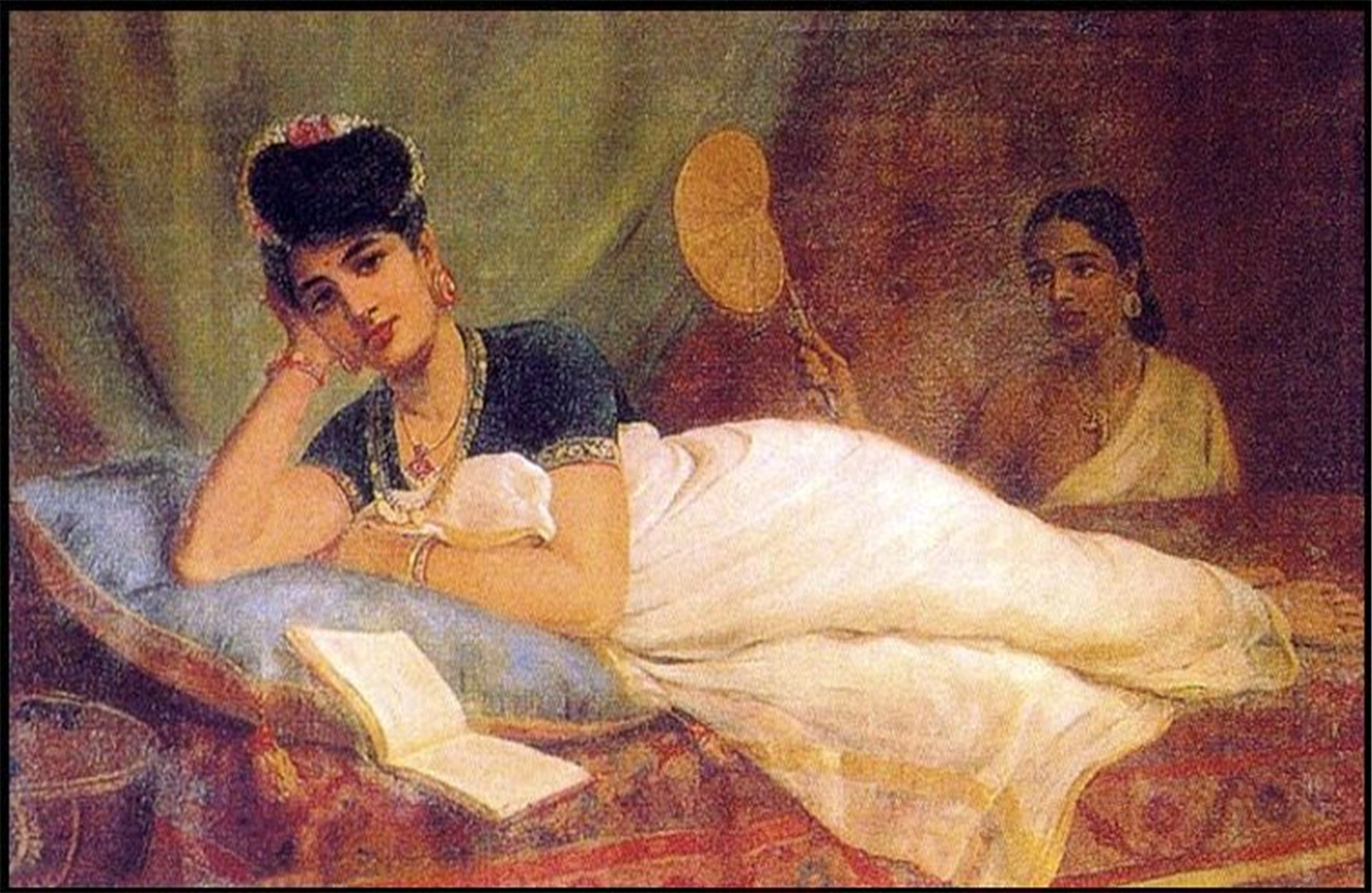
Fig. 1 Reclining Women (Undated) by Raja Ravi Varma, Oil on Canvas
Reclining woman of Varma has attractive gestures and position and similar treatment like Eduard Manet’s 'Olympia' made in the 19th century (1863), which may be a result of Western influence. In this painting, the main figure has been made in an erotic mood to seduce her onlookers. The background or negative space is constructed through the interior of a bedroom, which is also representing the state of waiting for her male counterpart. The bright color scheme has been used to make it catchy, where white and golden shades have been used to make the woman more attractive. In the close observation, it is found that the woman in this painting is pretentious enough to fake all the meanings of privacy. She is aware and conscious regarding her projection.
In Calcutta, the other noticeable movement has come after the contribution of the Tagore family and this period is also called the Indian renaissance period in the field of painting. This school, known as Bengal school, has been founded in the early 20th century and it has major significance in the revival of Indian modern paintings [13] [11] [14]. Calcutta has become a major center for all literary and artistic activities and Bengal school has been initiated by the Tagore family during the British Raj.
In the Tagore family, the most significant and leading personality was Abnindranath Tagore, nephew of Rabindranath Tagore, who made his style, in which, he depicted Indian figurative concept with foreign techniques after doing some experiment [3] [15]. The paintings of Abnindranath Tagore are filled with indigenous spirit, inspired by the miniature and other Western art styles.
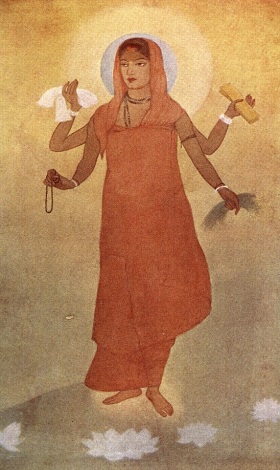
Fig.2 Bharat Mata

Fig.3 Krishna Lila – Bhabollasa
In numerous paintings of Abnindranath Tagore, the women have only painted for the political representation or for imitating the previous miniature style either they have their identity or not. For instance, the painting of Bharat Mata was only a source of political representation for doing protest against the colonial agenda. As well as, Abnindranath Tagore has represented the same erotica in the portrayal of women, which was prevalent in miniatures. Romanticism and sensuousness have been more focused on his works rather than any other noteworthy aspect. According to Appasamy,
“He uses his subject matter, his techniques, and his otherworldly beauty to communicate a feeling or to create a mood. He is not a moralist, painting for our edification but an artist painting for our delight. His pictures of the Gods are not icons meant for worship, but a poetic rendering of the imagery of the God” [16].
In the portrayal of womanhood, the sensuous and erotic imagery has been frequently repeated from the earliest times till the modern period, but it is differentiated and changed its way after the mark of Amrita Sher-Gill, who represented woman as a subject rather than an object. The representation of women has turned its meaning when female artists tried to capture the sad and tragic faces of women with their loneliness. In this way, Sher-Gill has changed the narratives in the depiction of a woman with a feministic approach and differentiated the gender significance in a unique style.

Fig. 4 The Swing
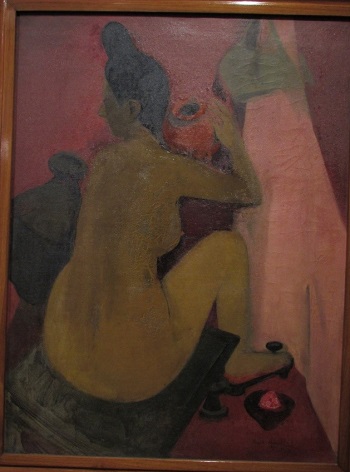
Fig. 5 Woman at Bath
The portrayal of a woman in the paintings of Husain has been often based on Hindu Goddesses, rural women, and his muses. In these subjects, her affection towards the female form has been observed. Husain, apart from his religious contradiction, which is imposed by some fanatic Hindu people, is one of the greatest artists under the sun. He has painted numerous images of the woman in which sometimes he has painted naked and semi-naked images too. His paintings of woman are most of the time represents his exotic feeling toward the woman as he mentioned that he is so much fascinated regarding the feminine and added, "what is this attachment" or "ye konsamohhai" [8].

Fig. 6 Lady with Blue Tiger

Fig. 7 Parvati
In the image titled 'Lady with Blue Tiger', the tiger may be a representative of male sexuality because, in India, male-sexuality has been always symbolized in animal forms. On the contrary, the painting (Fig.6) titled Parvati, made by a contemporary female artist, Anjolie Ela Menon is based on a very different aspect. In this painting, Menon has raised a mythological issue, which is associated with the helplessness of a Goddess (Fig.7). In this story, Lord Ganesha, son of Lord Shiva and Parvati, has been killed by his father because his mother (Parvati) has ordered him (to Ganesha) to not let enter anyone in her place. Lord Shiva came at that moment and in her anger and ego, he killed his son and Parvati had done nothing. Therefore, Menon painted the story with powerful gestures of Parvati than the helpless one. In this way, going through the comparison, both of the artists (Husain &Menon) has painted woman but in a very different and opposite manner.
Husain was the leading personality, who gave new directions to the field of painting and helped in the popularization of Indian art internationally. He had a keen interest in Hindu religious manuscripts. He has painted many series on Ramayana and Mahabharata and a series on Mother Teresa in very unique form but he mostly focused to showcase the charm and beauty of the woman in his singular style. Francis Newton Souza is known as the artist of devil-like images of women with heavy genital parts and strange faces. He has done thousands of sketches and from the very childhood, has been obsessed with female nude, his obsession is not only limited with his academic nude models but he used to watch his mother during her bath. It is stated by Raj that “Collectors and admirers, believes that he did over 12,000 sketches. Female nudes were an enduring obsession, with his early sexual stirrings triggered by watching his mother bathe through a peephole. By his confession: “I used to watch her bathe herself through a hole I had bored in the door... I drew her on the walls and prudes thought I was rude. I can’t see [17].”
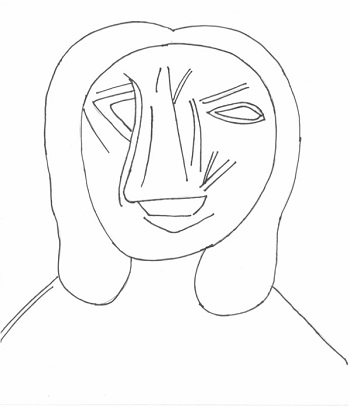
Fig-8 & 9, Devil Like women Images of Souza
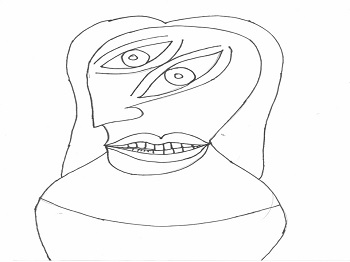
He has married four times and remained in controversies for his appealing and flaming nudes. According to Ghose[17], Souza was an iconoclast, his distorted figures challenged convention, his essays provoked the intelligentsia. He led a wildly interesting life, punctuated by many women, marriages, and divorces, split between the cities of Mumbai, London, and New York. His art enhanced the eye’s image of the world by distorting it. Like Georges Rouault and Francis Bacon, he was an image-maker (Fig-8, 9).
Unlike, the Indian feminist artist, GogiSaroj Pal, explores the women and their belongings only in her paintings after the revival of some earlier artistic icons of Indian art (Fig-10-11). The nudes of Pal are consecrated exceedingly with the commemoration of self-interpretation in opposition to the male dominating culture of society [18] [19] [20] [21]. After comparing the paintings of Pal and Souza, it is considered that their representations are entirely different from each other which may be a result of gender difference. The women in the Souza’s paintings are only the object of offerings with their horrifying appearances [9] [22] [23] [24].
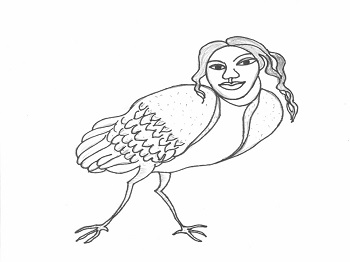
Fig 10 Kinaari Series of Pal
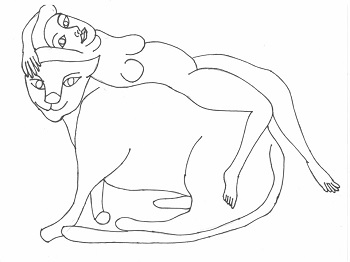
Fig-11 HatyoginiNayika of Pal
Pal has been represented her art focusing on women, in which she has encountered various issues to criticize the patriarchal and religious hegemonies. She also developed her narrative, which particularly constructs the role of the woman against such political display. Nalini Malani is also a contemporary feminist artist, who is working on paintings, media, and shadow play. She was born in Karachi in 1946 (in undivided India, now in Pakistan). She has made a painting titled 'Rethinking of Ravi Varma’, where she depicted the major female icons of Varma's paintings in a corner and painted her icons in the middle of the painting. The main focal point is a large female image, which is supporting Malani's icons in the process of rejecting those forms of Varma's paintings. This major figure is pointing towards the female forms of Varma, which may a way to reject those previously depicted forms of beauty and ornamentation.
In this voyage of the portrayal of women, the contemporary artist Jatin Das is capturing the same erotic and sexually charged woman with huge figures in bare forms. His main concern of paintings is the man-woman relationship, in which he mainly depicts nude female figures [22]. The woman has been depicted in huge muscular body-type which is a signature style of an artist in numerous paintings. Jatin Das has given much attention to muscular structure because he has made his role icon to Michelangelo as it is stated by Punja that “adopting Michelangelo as his hero, he produced 300 sketches everyday” [25]. So the anatomy and body structure has become his most preferred style from the beginning of his paintings, where bare bodies are portrayed.

Fig.12. Rethinking of Ravi Varma, Nalini Malini
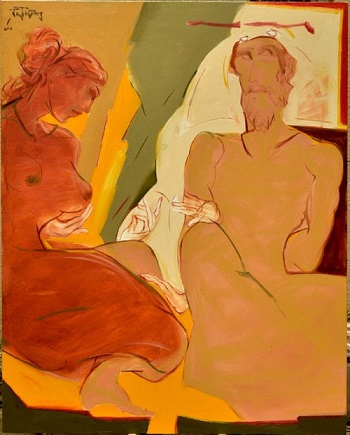
Fig. 13. Innovation, Jatin Das, 2011
In this way, the difference of depiction can be seen in both of the artist's works regarding the woman. The pain and suffering of womanhood, which was avoided earlier, encountered deliberately in Nalini Malani's work, who has taken the path of feministic ideology in which, she is engaged with his puppets in a series entitled Media. She also made a painting entitled, “Rethinking of Raja Ravi Varma”, for the reawakening of those people of society who considered Ravi Varma as an Ideologist [26]. Seema Kohli, an Indian contemporary artist, is also engaged to demonstrate the feminine potency and ascendancy with spiritual and sublime creativity (fig.14). The various postures of feminine characters are used, which looked like the protagonist and revolutionist and they are also the true forerunner of feminization in paintings [18] [27]. In another image (fig. 15), Ramchandran, a contemporary male artist has portrayed the same ancient concept of a woman at her toilet.
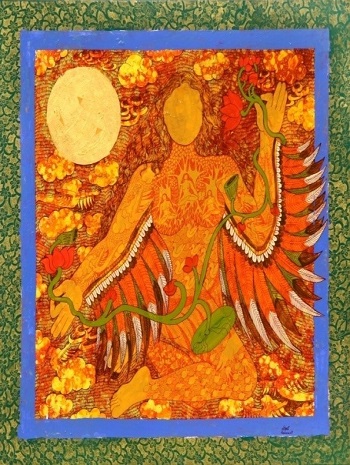
Fig.14. The Divine Feminine, Seema Kohli

Fig. 15. The Brides Toilet by A. Ramchandran
Ramachandran has made the same concept of semi-naked woman, showing her beauty and charm with the attendants. Thus, after Sher-Gill, there are a majority of female artists, who are engaged to seek some contributive role of the woman through paintings. On the contrary, many male artists are busy capturing the sensual imagery of women on their surface. In this context, as per the artistic representation, nothing can be taken entirely as offensive, whether it is a female portrayal or any other thing. Because sexuality in art, is not only associated with artists, but it is associated with the onlookers too. Therefore, the phenomenon of gender is also affecting their representations because individuals are channelized through the social construction of patriarchy. In such a society, the woman is symbolized with the divine power, on the one hand, and also symbolized as a medium to evoke erotic appeal, on the other. As Italian Philosopher Croce stated that art is an expression of impression not an expression of expression. Therefore, artists have their perception of female depiction in their paintings. Male artists have depicted women in sensual form, which is a way of representing art but their perception becomes questionable after the advancement and involvement of women in the field of paintings. The sensuous and erotic imagery of their own body may not be acceptable for them in the display because instead of sexuality, they have other significant roles in society. As a humanbeing, they also want equality and justice and painting is also a way to present such unfair issues of gender politics.
This is discussed already that such issues have been painted in Indian paintings by Sher-Gill, who changed the sensual imagery of a woman in a tragic display of their life. Ravi Varma’s so-called religious icons are full of erotic engagements and representatives of sensuous appeal in the disguise of mythical heroines [12] [2]. Husain was also fascinated by the magnificence of womanhood and derived by an emotional attachment towards Indian feminine. He also announced that his subject will remain women only in his last phase of life. His muses, including Madhuri Dixit [8] have been depicted in many of his works. On the Contrary, the painted women of Pal are not offering their nakedness for male-gaze because, being bare, they are celebrating their freedom and sexuality rather than seducing their onlookers, they are attacking this very gaze [20]. Souza was possessed by his vamps, who are imbibed with horrifying identity and lustful attitude; they also look like the whorish women of Bombay [9] [23]. Seema Kohli is fully against these phenomena and concentrated on the divine theme in her paintings where the Yoginis, ferries, myth, mind, and movement are playing with the entire world ironically. The work validates a woman’s spirituality, emerging aligned with the male dominating society [28] [27]. As well as, RekhaRodwittiya has inspired by feminist beliefs, in which the images are dealing with issues like isolation, degradation, subjugation, and harassment. Female artists are confronting such political issues through their female protagonists and used their own body to set the new paradigms in the representation of womanhood against the pre-occupied archetypes of male-centered art [20] [29].
The depiction of the female figure has been intermingled with the aesthetical delight in paintings from the recent past. This very depiction can always be considered in various phases of paintings in different identities and forms. In this concern, the objectification of women has been done to evoke sensual pleasure or to celebrate male-dominancy. This kind of objectification has come into notice after the arrival of feminist artists because representations of the feminine are better accomplished by the woman artists only. Being a woman, they can feel the avoidance of woman in significant roles on the painted surfaces, so the important aspects related to woman's pain and happiness has been observed appropriately by them. As per the analysis of historical to modern Indian art, the role of women in paintings has been mainly equipped to portray the most preferred forms, directed by patriarchal hegemonies. There are mainly two types of forms of women, the first one is related to beauty and sensual pleasure, and the other one is related tothe social code of conduct. This style of depiction has changed its way through the paintings of Sher-Gill, where poor or marginalized Indian villagers (woman) have come as a sight of exploration. Then female artists of modern Indian paintings have started to contribute significant subjects related to social injustice, gender inequality, and woman unemployment, and so on, to protest such issues. Unlike, the erotic and non-significant portrayal is still there but it is decreased to some extent. Nude or bare bodies of women are always considered as a form of objectification by numerous art critics. A naked figure of females is also considered as an aspect of gender politics but in modern times, the female artist has also depicted female nudes in a very different manner. Sometimes they also used their own body as a module and Sher-Gill is probably the first Indian woman to do so. In actual sense, the representation of female nude by female artists is entirely different than the representations of a male artist. This difference can be observed through their way of depiction because male artists have mostly preferred the sensual part through nudity while female artists have concentrated on other real issues. The naked body used by woman artists is not meant for erotic appeal, the body is portrayed to celebrate the freedom and sexuality of womanhood. The main subjects like Goddess, lover, dancer, attendant, mother, princess, and so on, are frequently depicted from the very ancient times till the colonial period. These subjects have been changed or transformed by female artists for questioning or rethinking. These subjects have been changed by female artists into the form of the working woman, female protagonists, and shameless nudes. The pictorial narratives of previous times, which are related to mythological themes, love poetry, waiting for the lover, male and female union sights, have been changed into the feministic fables. Space and background, which enhance those erotic and sensual appeals of the painting, have been changed into new dimensions, where female artists mostly used those supporting objects on a very small scale. Moreover, the background has been left empty or blank by numerous female artists, for instance, Sher-Gill and Pal has mostly ignored other background details. This avoidance or less consideration regarding the background of the paintings by female artists may be a way to give the main significance to the main figure (woman) only. In this way, the arrangement of color has been proved a better medium to create structures in the painting rather than other supportive objects.
Going through the artistic representations, it can be noticed that art does not belong to the artist only but it also belonged to its onlookers. In the field of art, there are numerous factors, which contribute to frame the artistic representation. In these factors, social factors and surroundings of the individuals play a major role because all art is related to the personal or social encounters of the individuals. Art or representation is something, which comes to the mind after getting inspired by something or to capture something. These things may be belonged to realistic encounters or imagination of the artists and represented on the surface for visual communication. Thus, art is the biggest and the easiest medium to communicate ideas and feelings in symbolic or non-symbolic forms. The artistic encounters are frequently connected, and in modern times, there are numerous elements, which are somehow adopted by the artists from the early Indian arts. The art of ancient times is particularly belonged to religious sects for promoting deities and rituals and it is always channelized by patronage or rulers till the pre-colonial period. Therefore, the artists had to portray according to the will of their patron, they have no individual liberty to depict what they want. Then art has also been used as an act of social discourse and woman depiction has also become a part of this religious and social display. For instance, the first imagery of women has been emerged in the form mother-Goddess or the Goddess of sexuality, worshipped symbolically through her genitals too. Because, at that time, sexuality and procreation may be taken as a universal bliss because people were amazed regarding the reproductive power and procreation aspect of the feminine. In ancient days, the people were unaware of scientific knowledge so the birth-giving power and sexual union are maybe considered as a divine task. In this way, fertility and procreation played an important role at that time and the sexual depiction of Lajja Gauri or the boon-giving aspect of mother Goddess has been accepted as a major subject. This Goddess imagery has been divided into numerous categories as per the various religions but beauty and ornamentation have always been preferred by the artists. The difference has been created, when artists became liberal after Independence and started to work individually. Female participation as professional artists has been increased and this participation changed the way woman's portrayal and these feministic ideologies have been somehow connected with previous representations. Female artists have mostly criticized or reinvented these previous forms of feminine and male artists have adopted such erotic or sexual representation as per their choice.
Conclusion
To conclude, it has been found out that the depiction of women by male artists is entirely different than female artists. In the portrayal of woman, her physical beauty and sensuous forms have been particularly made before the female participation in the art field. There is a big lack of significant subjects and only objectification is mostly preferred in the depiction of women. To some extent, being a woman, female artists have the right to shift such offerings into some subjective compositions to show their other accomplishments besides of aesthetical and physical depiction. Therefore, the voice of feminism has been raised by some female artists through their paintings, in which, they are often used their bodies to depict themselves nude in front of society. But, the nude depiction of the female body is entirely different than the male artists in all verifications. On the contrary, the male artist who has depicted female figure in full erotic and stigmatic manner are not quiet guilty because physical beauty of a woman is celebrated and encountered from the very ancient age of art. Here, the thing is being considered that in ancient age the social status of the woman is not much improved than today but now, the female has the power for proclaiming their individuality through art.
On the other hand, if male artists are exhibiting such sensuality of female figures, their freedom of expressing themselves cannot be ignored but the objectification of womanhood is always being a radical phenomenon. This phenomenon has been occupied with various factors, i.e. the societal perception, the psycho-analytical vision of the individuals, and the inner consideration.
References:
- Garimella, A. (1998). Engendering Indian Art. In V. Dehejia (Ed.), Representing the Body- Gender Issues in Indian Art (pp. 22-41). New Delhi: Kali For Women - In association with the Book Review Literary Trust.
- Thakurta, T. (1991). Women as ‘calendar art’ Icons: Emergence of Pictorial stereotype in colonial India. Economic and Political Weekly, 26 (43), WS91-WS99.
- Thakurta, T. (2005). Lineages of the Modern in Indian Art: The Making of a National History”, Culture and the Making of Identity in Contemporary India, pp. 71-107.
- Kumar, S. (1999). Modern Indian Art: A Brief Overview. Art Journal, College Art Association, 58 (3), 14-21.
- Mitter, P. (2007). The Triumph of Modernism, India’s Artists and the Avant-garde 1022-1947. London: Reaktion Books Ltd.
- Dehejia,Vidya. Representing the Body: Gender Issues in Indian Art. Kali for Women in Association with the Book Review Literary Trust, 1997.
- Nochlin, Linda (1989) "Why Have There Been No Great Women Artists." Nochlin, Linda.
- Women, Art, and Power and Other Essays. New York: Harper & Row.
- Chandra, P. (2012). M.F.Husain-a Pictorial Tribute. Niyogi Books Publication
- Kapur, G. (1978.). Modern Indian artists. New Delhi: Vikas Publishing House
- Nadkarni, D. (1996).Husain- Riding the lighting. Popular Prakashan
- Kumar, Ravi (2008). Das Mahavidyas-Ten Creative Forces. Paris: Ravi Kumar
- Uberoi, P. (1990). Feminine Identity and National Ethos in Indian Calendar Art. Economic and Political Weekly, 25 (17), WS41-WS48
- Banerji, D. (2009). The Alternate Nation of Abanindranath Tagore. London: Sage
- Reynolds, J. (2006-7). On a Wider Canvas. India International Centre, 33 (3/4), 262-273.
- Kumar, R. Siva, and Abanindranath Tagore. Paintings of Abanindranath Tagore. Pratikshan, 2013.
- Appasamy, J. (1968). Abanindranath Tagore and the Art of his Times. New Delhi: Lalit Kala Akademi.
- Ghose, A. (2010). The Resurrection of F. N. Souza.
- Kumar, R. (2008). Das Mahavidyas-Ten Creative Forces. Paris: Ravi Kumar Publishers.
- Bawa, S. (2000). Gogi Saroj Pal-the Feminine Unbound. New Delhi: Delhi Art Gallery.
- Lutzker M., A. M. (2002). Five Artist from India: Gogi Saroj Pal, Rekha Rodwittiya, Navjot, Anupam Sud, Rummana Hussain. Woman’s art Journal, 23 (2), 21-27.
- Sen, G. (2002). Feminine Fables-Imaging the Indian Woman in Painting, Photography, and Cinema. Ahmadabad: Mapin Publishing House.
- Mago, P. (2002). "Contemporary Art in India" a perspective (2 ed.). New Delhi: National Book Trust, India.
- Tulli, N. (1997). The Flamed Mosaic-Indian Modern Paintings. Mapin Publication, 3-7.
- Saffronart. (2012, June 19-20). Modern and Modern Indian art. Summer Online Auction, pp. 43-48.
- Punja S. (2003). The Art of Jatin Das. Roli Books.
- Kapur, G. (2000). When was Modernism-Essays on Modern Cultural Practices in India. New Delhi: Tulika Prakashan.
- Pande, A. (2009). Swayamsiddha, Myth & Movement. New Delhi: Gallerie Nvya.
- Wal, A. (2013). The Goddess of All Things. Tehelka.
- Farooqi, A. (1986). Indian Women Artist. National Gallery of Modern Arts.